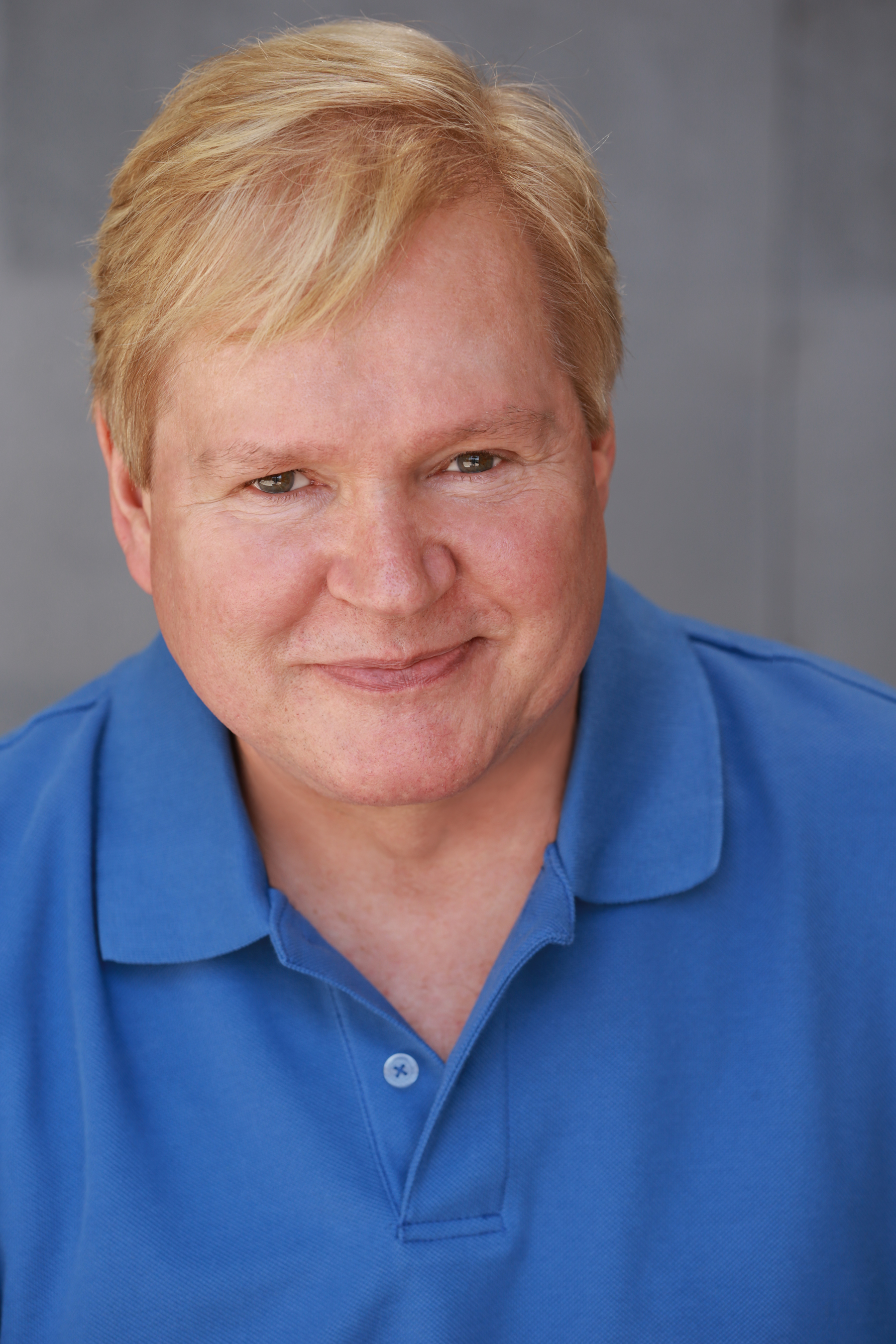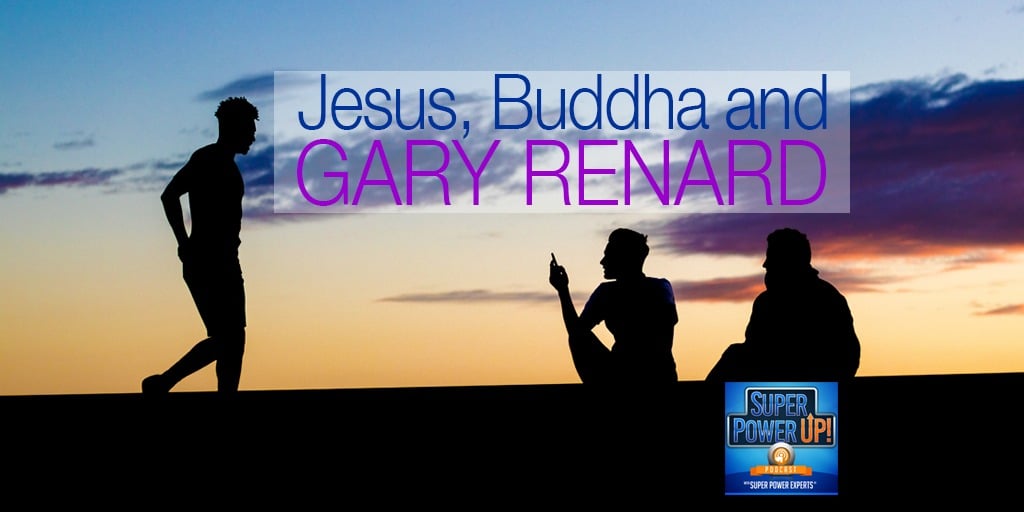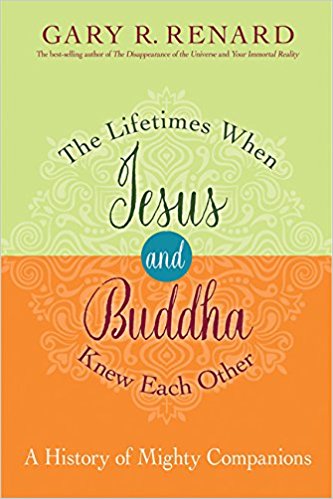
Gary Renard does it again. In his fourth book, The Lifetimes when Jesus and Buddha Knew Each Other, he boldly goes where few dare to tread. He makes uncompromising claims that Jesus and Buddha had other lifetimes and were together during most of them. Fueled by a deepened relationship with his spiritual guides, Arten and Pursah, Gary sheds light on many areas left dark and empty by most religious teachings. Listen in as he tells Tonya Dawn Recla all about it.
Gary R. Renard is the best-selling author of The Disappearance of the Universe, Your Immortal Reality, and Love Has Forgotten No One. During the last few years, Gary, often joined by his wife, Cindy, have been busy teaching A Course in Miracles in 31 countries and 44 states, with multiple visits to many of those locations. Combining a disarming sense of humor with radical, cutting-edge metaphysical information and experiential exercises, he has been described as one of the most interesting and courageous spiritual speakers in the world.
Hello everyone, this is Tonya Dawn Recla, your Super Power Expert and I am just thrilled to have with us today, Gary Renard again. So luckily he has agreed to come back on the show and talk about super important topic, which happens to be his latest book. So well today’s show we’re talking about Jesus, Buddha and Gary Renard and his book, The Lifetimes When Jesus and Buddha Knew Each Other, a History of Mighty Companions. It’s absolutely magical so I’m very excited to share this with you today and super, super honored to have him with us. Welcome, Gary.
Well Tonya it’s great to be with you again and yeah, I’m really psyched about talking about the new book because it went in directions that I didn’t expect and it dealt with some teachings that I didn’t really know very much about and then there was this series of lifetimes that the world doesn’t know about, where Jesus and Buddha actually knew each other and helped each other along their spiritual path. Which is something that nobody’s written about, so I just got very excited about it as it went along.
Oh I can imagine. I was excited as I went along reading it.
Yeah so, it had all kinds of surprises in it for me. Not the least of which was that … I always assumed that because the way the Arten and Pursah told their story in my first three books that I would be coming back for one more lifetime or as A Course in Miracles puts it, I would be coming back to mentally review one more lifetime in order to be enlightened and complete all of our lessons.
And in this book they told me well you know actually you’ve done forgiveness work where you would not necessarily be something that you will have to do. Maybe you don’t have to come back and review one more lifetime. Maybe this is the last one.
So that got me pretty excited ’cause it made me realize that I … It’s good to do your forgiveness all in one because it pays off and maybe this is my final time around. Which would be fine with me because you know I’ve paid off … I’ve had enough of the world. It’s not that I have anything against it, you know I enjoy it and I just had a wonderful cruise to Hawaii, had a beautiful time and the world can be a happy dream but I think at some point, and this is a personal decision on everyone’s part, but I think at some point people decide that it’s time to go home. And once again, that is a personal decision. You can’t make your decision for somebody else. It’s something that they have to do for themselves, which why I always say that spirituality is a personal thing that allows personal decisions.
The only piece of advice that I would give about that is that when you make a decision, do it with the Holy Spirit. Don’t do it alone because when you’re connected to that higher place, the Holy Spirit, then you can be inspired and of course the word inspired comes from the words “in spirit.” Just as the word “astral” means like above.
Well, when you’re connected to the astral, when you’re connected to above, then you can be guided to the right decision. If you’re not connected to that higher place, well, astral means aster and if you’re not connected then that’s where the word disaster comes from.
Mm beautiful.
That’s what leads to disaster. When you’re not connected to that higher place. One of the things that the fourth book leads to is the undoing of the ethos, of course where it says salvation is undoing. But it actually explains how Jesus and Buddha did that which is really important to me because I always wondered, how did Jesus get to be Jesus? How did Buddha get to be Buddha? What were they like in the lifetimes just before that? What things did they study? Who did they study with? How did they undo their egos to the point where they could come back for that last lifetime and be enlightened and kind of like point other people in the right direction and do the things that they did.
This book actually answers those questions and I say at the beginning of it I always wondered about Jesus and Buddha but I always used to forget to ask Arten and Pursah my teachers about it because when they show up I get taken with them in the sense that I’m amazed that they’re there.
For those who have read my books they know that Arten and Pursah actually appeared to me as people and carry on pretty normal conversations with me. Of course very spiritually advanced but they’re still normal conversations that people can relate to and-
Gary, can I ask you a question about that?
Sure.
How you reconcile that as you’re talking with them, knowing that kind of aspect of they’re you, you are them, there’s only one in the purpose of The Course uses in the Sonship. How does that feel to you as you’re talking with them as your teachers but also as you?
Well, fortunately for me, even in the first book, they pretty much explain what they are and what they are is the Holy Spirit and what the Holy Spirit has to do is take on some kind of form in order to communicate with us. If it didn’t we’d never be able to hear it.
Now usually, for most of us, most of the time, that form is going to take the form of ideas. Ideas that come into your mind and the idea has a shape to it, has a form to it. Has words. And the Holy Spirit as The Course says, is the voice for God and has therefore taken form. This form is not his reality.
So what my teachers are saying, what The Course is saying, is that there is a reality behind the form. And the reality behind the form is the Holy Spirit, which is spirit, which is still perfect oneness with God. The only difference with the Holy Spirit is that the Holy Spirit takes on a form so that we can hear it in such a way that the Holy Spirit can lead us home. Lead us home to God.
Once again, if the Holy Spirit didn’t take on that form we’d be stuck here forever because we’d never be able to hear it and we’d just be wondering around in the dark instead of being led home by the Holy Spirit.
Now, once I understood that I realized that, okay, Arten and Pursah, my teachers, are really the Holy Spirit but the Holy Spirit is taking on a form in order to communicate with me and once i realized that, I became more comfortable with that, even though I’m always amazed when they … I started to become more comfortable with what they were.
Who says things like, there are those that have reached God directly, retaining no trace of worldly limits and remembering their own identity perfectly. These may be the teachers of teachers because although they are no longer visible, their image can yet be called upon. So Arten and Pursah as ascended masters are out of here. The real Arten and Pursah that are, or I should say, the Arten and Pursah that lived a lifetime in Chicago are home with God and what happens is the Holy Spirit uses their image to communicate with us.
So that’s why sometimes the Holy Spirit can show up in different ways for different people.
So what about people then? Like, people in your life, is that the same concept or how does that work?
It’s exactly the same concept. The only problem is that most of the images we see and most of the bodies that we see, which The Course also describes as images, are simply being projected by the wrong part of the mind instead of the right part of the mind. So most of the images we see are being projected but the ego part of the mind and when it comes to certain images like Arten and Pursah ascended masters, and this can also apply to like angels or the Virgin Mary. I know Saint Germain has been appearing to people for decades at Mount Shasta and those are manifestations of the Holy Spirit. So there is a difference. And the difference is whether or not the manifestation is coming from the right part of the mind or the wrong part of the mind and then what happens is, as individuals, or at least we appear to be individuals even though that is all an illusion, because it’s really just one of us appearing as many as the Hindu’s would put it.
The way it works is, the Holy Spirit slowly retrains our mind to think with the Holy Spirit instead of the ego and that is how we are transformed into being one. Which is what we really are but we’re not experiencing that. The Holy Spirit is taking our mind and training it to think with the Holy Spirit instead of the ego and ultimately replacing ego with the Holy Spirit.
As that happens with you, then your experience starts to change slowly, but surely, from an experience of being a separate body to the experience of being what you really are in where you really are, which is this perfect spirit that is exactly the same as your creator, which is God.
So wouldn’t that also be true of the figures of Jesus and Buddha?
Well the difference with Jesus and Buddha was that they were no longer experiencing the ego. They were no longer experiencing the false self. So they were no longer experiencing themselves as bodies even though they appeared to be here, their experience had completely changed to the point where the body starts to feel like the figure in a dream that it really is.

Forgiveness denies the ability of anything not of God to affect you.
So the body starts to get lighter and it starts to get less dense and more elastic and more difficult to hurt and then at the end of your earthly lessons you get to the point where you cannot be hurt. I love the way that A Course in Miracles describes forgiveness at one point. It says it denies the ability of anything not of God, to affect you.
Mm I love that.
Yes, you can get to the point where the world can’t hurt you. Where it can’t have any affect on you and-
Gary can you repeat that forgiveness denies the ability …
Yeah alright, it denies the ability of anything not of God to affect you.
Thank you.
So you know, you can get to the point where people can’t hurt you. Somebody calls you a bad name or something or slaps you in the face or tries to destroy your career or something then you can get to the point where you can’t be hurt by that or you can’t lose your peace and your strength and if you can maintain your peace and your strength regardless of what happens in the world, not because of what happens in the world, but regardless of what happens in the world, and that is real power and that real spirituality.
That’s freedom.
Yeah it’s freedom. Absolutely. Those are the kinds of lessons that Jesus and Buddha learned in these … I describe six different lifetimes in the book where Jesus and Buddha actually knew each other and helped each other and it really starts out in Japan, 700 BC when they were both into Shintoism and it describes their life there, what they learned. There was a certain shamanistic quality to it, it would actually communicate with the animals and they were just into Shintoism and of course it was a different world, it was a different culture. People were like personal possessions, like the emperor.
At the same time there was enough freedom that they could study the power of the mind and start to get in touch with the power of the mind.
Then, in the second lifetime that I describe, they’re in China but 100 years later and they’re into Daoism and they actually studied with Lao Tzu and learned a tremendous amount from him because Lao Tzu was kind of like a predecessor of Buddha. He had a lot of similar ideas to Buddha and sometimes their quotations are actually confused with each other because they were very much alike. It’s just that, there’s a little bit more Chinese culture with Lau Tzu.
Later, Buddhism, it never really caught on in India and the third lifetime that I describe is actually when Jesus and Buddha were Hindus in India and these lifetimes are roughly 100 years apart.
I remember Arten and Pursah saying earlier in the books that we tend to incarnate about once every 100 years or so.

In meditating I could achieve absolute stillness.
In Hinduism, they continue to learn a great deal and got into meditation heavily and I think that any kind of mind discipline including meditation is a good thing because it makes you more aware.
I know that when I got into meditation a lot when I was around 40 years old, 40, 41, 42. I got to the point where, the way that it’s described in the book that by meditating I could achieve absolute stillness. I felt like I could get to a point where there were no interfering thoughts in my mind.
That really helped me a couple of years later when I found a course in miracles. Started getting into The Course and doing the workbook of The Course. I found that because my mind had been disciplined to mediation, that it really helped me. To do work at The Course and to visualize things and to really get to the point where I was relating to the ideas that were in the workbook, even after I put down the book and I wasn’t doing the lesson. It made it easier for me to apply the ideas in my everyday life and what this book, Lifetimes that Jesus and Buddha Knew Each Other, it started putting me more back in touch with that and realized that I’d done some things right and we all make mistakes but at least I had done some things right.
We get to the fourth lifetime and this is where Jesus and Buddha … By the way, that had all different names of course in all these lifetimes, they weren’t Jesus and Buddha until they were Jesus and Buddha. Their names … I had kind of a hard time writing this because I wasn’t that familiar with some of the teachings that they relate to and they tell stories about their lifetimes and what they were like and so many experiences that they had. I wasn’t used to that kind of writing. I was used to just straight narrative type transcript or something. There was a lot more descriptive writing in this book so that was a new experience for me.
In this first lifetime we talked in Japan their names were Saka and Hiroji and they were just friends. They were friends but they were in love with the same woman. So this didn’t make things too easy. That was a good forgiveness opportunity. In the second lifetime when they were into Taoism in China their names were Shao Li and Wosan and in that lifetime they were romantic partners. They ended up being two people who were very much in love with each other and in the lifetime in India when they were Hindus their names were Harish and Padmaj and I have a hard time remembering these names.
Yeah I’m sure.
I’m not really good at foreign languages. I have no aptitude whatsoever for foreign languages.
You’re so funny.
And in Greece, this is the fourth lifetime and in that lifetime they actually were at Plato’s academy at one point and knew Plato and realized that a lot of what he was saying was valid but that there was something missing. They were getting to the point that they realized that there was something missing.
And this is where the subject of non duality comes up in the book. Arten and Pursah, by explaining these lifetimes really make a distinction between duality and non duality and then what you begin to see is all of these disciplines, that they’re studying, whether it’s Shintoism or Daoism or Hinduism or you know, Plato’s Academy. There’s a common thread that is coming from all of these great teachers.
What they were all saying, this can be verified if anybody really wants to look into it, but what they were all saying is that you have two things and only one of them is real. You have reality, which is oneness and then you have anything else and anything else that is not perfect oneness is not true. It’s not real. That’s an important thing that comes up in the next couple of lifetimes and especially when you have the lifetime of Buddha whose name was Siddhartha. A lot of people use the name Gautama when referring to Buddha but my teachers never used that name and by doing so I think that they were saying was look, if you were saying his name in English, Siddhartha would probably be the closest.
Then, at the same time, there was this guy named Rahula and it’s not really held at first, but as the chapter goes on … I don’t think I’m giving away too much because it’s fairly well known, even though not accepted by some Buddhists that Buddha had a son and it turns out that in that lifetime that Buddha’s son was the one who would be Jesus. In that lifetime.
So they had all these different kinds of relationships. They were fellow students, they were friends, they were lovers, in the Hindu lifetime they were cousins and it so happens that in this lifetime, Jesus turns out to be Buddha’s son, Rahula, and the forgiveness lessons that they both had to go through in that lifetime are pretty well described and by the end of that lifetime they’re both at the point where they are enlightened, for all intents and purposes.
But, there was one step that had to be taken even though Buddha knew everything he had to know to be enlightened and so did Rahula who would be Jesus next time around.
I thought it was kind of cool by the way, towards the end of that chapter, because Buddha says to his son, “Hey next time, you be the teacher.”
I love that. I love that part.
So at this point they have both learned so much and undone the ego so much that they’re up to the point that they’re enlightened but at the end of that lifetime they’re both acknowledging that there was something missing.
And one of them says to the other, “And I think you know what it is.”
So, in the final lifetime … And by the way, it was revealed in … I got a kick out of this because if you look back to my first book, Arten and Pursah said that Buddha came back for one more lifetime and that he was Buddha, which most people don’t know about. They didn’t describe it, they just said that Buddha came back one more time and that he was someone that most people wouldn’t know about.
So when you get to the final times of Jesus and Buddha and you know, this is during Jerusalem … Started off … Jesus starts off in Nazareth, he wasn’t born in Bethlehem, he was born in Nazareth and spent a lot of time in Jerusalem and the surrounding area. One of his disciples who we would know as Phillip … And it’s interesting because there’s a gospel of Phillip from the Nag Hammadi library but his name was Nadav and he was a disciple of Jesus and of course Jesus’s name was Y’shua it wasn’t Jesus but we’ll call him Jesus for the purposes of this discussion.
Phillip was kind of like the ultimate follower because he was Jesus’s equal. So they were the same, they just let Jesus do the speaking. And they describe a lot of what it was like. Most people know that the apostle Paul spoke at the Parthenon in Greece about 20, 30 years after. Not about Jesus. What they don’t know is that Jesus spoke there too and this was when he was on his way home from his travels. He travels for a long time. Got back to Nazareth at first when he was around 30 and they described that time that he got up in the temple and he said to do the scriptures are fulfilled and the people were looking at it like, “That’s blasphemy. The scripture wouldn’t be fulfilled unless the messiah was here. So are you saying he’s the messiah?” And he was lucky to get out of there alive. Because they just thought of him as being the kid that grew up there and being the carpenters’ son.
Actually his father, Joseph, was actually a stone mason but everyone thinks of him as being a carpenter and this is when Jesus said a prophet is not without honor except in his own home and with his own family.
Some people say you can’t be a profit in your own town. I make a joke out of it, actually you can’t make a profit in your own town. It was said, I gotta get outta here and speak some place else and he traveled all over the countryside and ended up in Jerusalem but they explained that, they didn’t have microphones back in those days and once in a while there’d be a really big crowd and so the way they did it was kind of like a relay. They would have Jesus say something, he was the speaker, but then about fifty yards back somebody else would repeat what he had just said so that the people could hear it. And then another fifty yards back somebody else would repeat what was just said and that was their way of allowing everybody to hear what was being said because there’s no way they would be able to hear a couple hundred yards back without a microphone, what this guy was saying.
I love that explanation because otherwise your mind kind of gets wrapped around how is this possible? Gary, I want to take a quick break but you mentioned the word blasphemy and I want to revisit that because obviously, and I’m sure you know this, probably had these thoughts as this you were having these conversations, this is not information that a lot of people are going to enjoy or accept readily because … You’re suggesting that Jesus and Buddha … Not suggesting, you’re flat out stating, that Jesus and Buddha had these various lifetimes together and that it wasn’t quite what has been depicted in the Bible so when we come back from the break I really want to dive into that aspect of it with you in addition to a couple other pieces. So stay tuned, we’ll be right back. We’re talking with Gary Renard about Jesus and Buddha. We’ll be right back.
To listen to the entire show click on the player above or go to the SuperPower Up! podcast on iTunes.
Podcast: Play in new window


